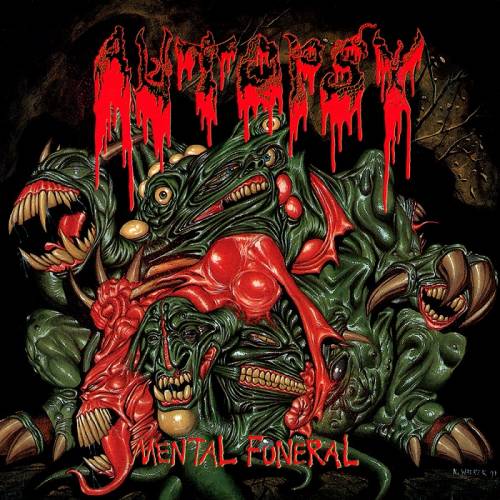
Upon initially hearing “Dead” on Autopsy’s Mental Funeral. Many would imagine that the second half consists of the same idea played on two different octaves before being harmonized together. While the call and response nature of this section may allude to that, the truth is surprisingly more complex as Chris Reifert and co decide to explore a much trickier idea of contrasting two related ideas played in opposition before reconciling them. Such notions are abound in rock music where the voice will alternate with the guitars during the verse before uniting with the chorus but in Metal such attempts have been met with general laughter. The more technical Hardcore bands would then introduce the poisonous and confused idea of then contrasting two completely unrelated ideas. Here Autopsy show that despite the simple nature of the melodies, that they are truly masters of the genre.
Lead guitar:
Starting a semitone beneath the root note of C before quickly jumping to the fifth and alternating between the fifth and the diminished fifth before briefly jumping to the root note and then restarting the whole process. Though this melody is completely contained within the harmonic minor scale it breaks away from convention by giving the root note very little consideration as to disorient the listener and by making the chromatic motif the central aspect of this melody, the piece retains its morbid character instead of transforming into an homage to oriental music. The unconventional jumps from the raised seventh (which is what gives the harmonic minor its oriental quality) to the fifth can be seen as an augmented fifth which is known for context based dissonance, meaning that depending on the context it is either sombre or dissonant but due to the contrast provided by the following chromatic dissonant, it is more apt to describe it as sombre rather than dissonant. The second lead guitar plays a slightly different variation on each iteration of the melody that harmonizes with the first lead guitar in a slightly different way each time that adds more depth and keeps the song going forwards in all its morbid glory. Throughout the song the band takes this melody and moves it around the guitar neck and even plays with some of the intervals by starting on the root and incorporating the minor scale as it descends into dissonant chaos before smoothly resolving at the end with both lead guitars diverging slightly towards consonance.
Rhythm guitar:
played completely in power chords with the added octave the riff is announced by two strokes of the root note before jumping into the fifth and then going down a major third to the minor second and then following a similar chromatic pattern as the lead guitar by jumping around with the second. The major third adds a twisted sense of joy before utilizing the most dissonant interval possible as it flirts with the idea of stability before returning to the comfort of the root note and repeating the whole process. Autopsy constantly flirt with setting up traditional melodies until they destroy them with brief dissonance and chromaticism. The use of the major third may seem minute here but it conveys Autopsy’s dark sense of humour as conventional beauty is destroyed in search of the depravity existing in man.
The superposition of both these ideas concludes this song perfectly as the lead guitar uses the more chromatic iteration of this melody in conjunction with the rhythm guitar to create a cold and uncaring conclusion as the mystery of the former is toned down and counters the joy of the latter for a purely nihilistic conclusion to this composition. The major third transition is superposed by a transition to the minor second which creates even more dissonance before being resolved by the rhythm guitar returning to the root note and the lead guitar flirting with the root note in favour of the raised seventh.
N.B All available tabs of this song contain many errors.
Tags: autopsy, brief analysis, call and response, Dead, Mental Funeral


I want this song played at my funeral